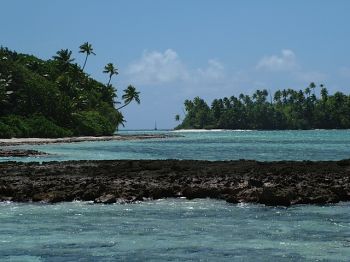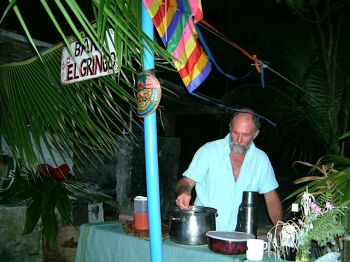Provisioning Tricks: Fish Tacos in Chagos
Clark August 7th, 2013

Reading Amy Schaefer’s story got me thinking about provisioning, and following Julia Child’s recipe for coq au vin showed me how to tell the story.
Julia Child doesn’t assume you know how to sautee mushrooms (there’s more to it than you think) or parboil onions, so in the middle of her coq au vin recipe she refers you to the appropriate pages and you learn as you go. I will do the same for preparing fish tacos in Chagos, and the required advanced provisioning.
These are Baja-style fish tacos, which I came to love as a kid in San Felipe, but now you can order at your local Chili’s.
Prep time is about two hours. This is a meal to prepare when you’ve been anchored in the same spot for a few days and you’re ready to buckle down in the galley.
We start with fresh fish, which you have caught or been given. Much has been written about fishing while cruising, so I won’t belabor the subject here. Any kind of fresh fish will be great for tacos:

The most time-consuming part of the job is making tortillas. The recipe is simple – flour, water, and a little oil – but it’ll take half an hour of flattening and grilling tortillas before you have a respectable stack. Flour keeps indefinitely aboard with little effort. Ms. Schaefer recommends putting a bay leave in each ziplock bag of flour to keep out the weevils. I go for a little more oomph and put a cotton ball, soaked with chloroform, then wrapped in paper, in each bag of flour. The chloroform also good for eliminating unwanted crew members.
The fish is breaded and fried in oil. A simple batter of beer, salt, and flour tastes great, and of course you’ll be brewing your own beer aboard. These ingredients also keep indefinitely.
A tiny bit of something fresh goes a long way toward making meals pop while cruising, a theme we’ll explore further. Nothing gives you more bang for your buck in this department than fresh herbs. A little herb garden is easy to maintain while cruising. Oregano is tough and will survive salt water dousings. Basil with die with the slightest whiff of sea water. Some chopped, fresh oregano makes the beer batter something special:

So far, for our batter and our tortillas, we’ve used all dry goods.
Fish tacos are always served with shredded cabbage, not lettuce, and of course cabbage keeps a long time. Peel off the outer leaves until you get to good ones, then shred the good ones. If you cut into your head of cabbage with a knife, the whole thing will go brown. Peel as you go and your head of cabbage can serve you for months.

Pico de gallo, one of the toppings, is made from tomatoes, onion, garlic, lime juice, salt and pepper, green chilis if you’ve got them, dried chilis if you don’t. Onions and garlic keep forever, but they need their own place. If you store them with your potatoes, eventually the onions will rob moisture from the potatoes and dry them out or spoil them. Bananas also need their own place, as they make everything near them ripen too quickly. All the other produce can live together, more or less.
Before leaving port, scout out fresh tomatoes that haven’t been refrigerated, and get some green ones. Along with all your other fruits and veggies, soak for about ten minutes in a five gallon bucket full of water with a tablespoon or two of chlorine bleach. Dry completely in the sun, then individually wrap each item in newspaper. The bleach kills surface microbes that might start decay; newsprint contains some antimicrobial chemicals and keeps out the light.
Layer the wrapped fruits and veggies in crates or laundry baskets that have good air flow, and store them aboard somewhere darkish, also with good air flow. If you store them in a locker, you’ll have a science experiment on your hands in less than a week. On most cruising boats, the produce baskets have to live on bunks, where they get plenty of air. Unwrap and inspect each item every day or two. At the first sign of spots, eat them! Through this method you’ll have fresh stuff for several months, at least, even in the tropics. The dregs can be surprising: you might find you’ve still got a green tomato several months into a cruise, and of course apples, pumpkins, and certain squash can have amazing longevity before spoiling.
So back to our pico de gallo: We’ve got the onions, the garlic, the tomatoes, a little salt, and now we need some fresh lime juice. This is perhaps the best trick in long-term provisioning: If you wrap a lime in aluminum foil and put it in the fridge it will stay from-the-tree fresh for up to six months. I mentioned how that little spritz of something fresh can impart freshness to an entire cruising meal? That squeeze of fresh lime juice is that spritz. For example, you can make a salad of canned corn and canned beans, which might taste pretty drab, but squeeze on some fresh lime juice, and it’s got zing.
You’ll also serve a few lime wedges with your fish tacos, to be squeezed on top.
The final topping for our fish tacos is the cream sauce, which is actually a souped-up mayonnaise, mixed with yogurt, sour cream, or just some extra lime juice. Making mayonnaise is NOT straightforward – there’s a bit of a knack to it – but the ingredients are simple: oil, egg yolk, and an acid such as vinegar or, you guessed it, lime juice. Most cook books tell you how to make homemade mayonnaise, either by whisk or with a blender.
Oil keeps for months or years, we’ve been over the limes, now to the eggs. Eggs are great for cruising because they keep unrefrigerated for about six weeks. We’re nuts about refrigerating eggs in the US, but it really isn’t necessary. They cook better at room temperature anyway. If you can find eggs that have never been refrigerated, they’ll have a very long life ahead of them. As they begin their decline, there’s a lot of warning: First, the yolks start breaking easily, then, finally, they start to smell when you crack them open, so cracking into a bowl for the smell test is SOP later in a cruise. With one or two of your eggs you can make your mayonnaise/cream sauce.
So now we’ve got homemade, steaming hot tortillas, fresh fish fried in a beer or egg batter, served with shredded cabbage, fresh pico de gallo, cream sauce made from homemade mayonnaise, served with lime wedges – all two months into a cruise without reprovisioning.
Whether or not to have refrigeration is becoming less of a question. Small systems that utilize the Danfoss BD-50 or BD-35 compressors keep getting cheaper and more efficient. My current system (a BD-35) only uses 25 amp hours per day – and makes ice cubes! (a few) In this recipe there’s really nothing that requires refrigeration, but the lime trick sure is slick.
We were very proud of ourselves for turning out this meal in Chagos for a Cinco de Mayo potluck, but then more advance cruisers came out with chicken tostadas, using chickens they’d canned themselves in Malaysia six months prior.

I’ve read stopping by Chagos is not allowed, as it’s considered a “security zone”. Is it true? How about the cloud of mosquitoes in this tropical paradise, any? And fresh water? Thanks for answering.
I think just Diego Garcia is prohibited because of the military base. Latest requirements for visiting are on noonsite: http://www.noonsite.com/Countries/Chagos?rc=Formalities#Clearance
Plenty of water in wells and catchments on Bodham Island in the Solomons. I don’t remember any mosquitoes.